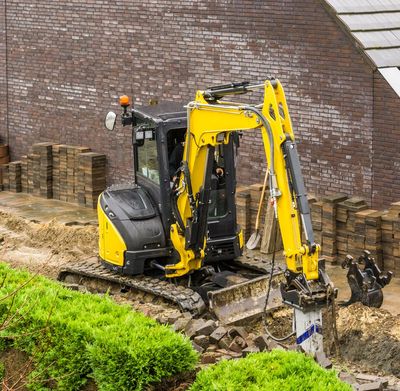Effects of Home Construction and Gardens
Every plant in the garden has the potential to become injured during construction. While plants becoming trampled or simply being run over are obvious causes, roots, stems and branches of trees are also at risk. Simply allowing the construction crew to run rough shod over the property can cause any amount of damage and even plant death. Avoiding construction damage to plants ensures continued ecosystem balance and preserves the appearance of the property. Many simple methods can help make home construction and gardens complement each other instead of cause destruction. New home construction is one of the more damaging to existing plants. Large machinery is needed to excavate a foundation or basement and roads need to be built and established to accommodate vehicles. Piles of soil placed over plant roots can limit their ability to get water, nutrients and air. Reducing trees on a lot to provide for construction space exposes the remaining plants to winds while they are also jarred by heavy vibrations from machinery. Often, construction crews randomly prune trees to help them get the machinery into a site, which can cause weak plants and unstable canopies. The off gases and chemicals used in many construction projects can also affect plant health. Simply bulldozing over a site smashes plants, uproots flora and rips out entire bushes and shrubs.
How to Protect Plants during Construction
Pruning correctly and precisely can protect many plants. This may extend to more than removing woody material and may include root pruning. Often, an arborist is needed to perform initial maintenance correctly. In some cases, the entire tree or plant needs to be temporarily moved to protect it from machinery and provide a clear path for workers. Smaller plants can often be dug up and the roots wrapped in burlap that is kept moist for many weeks. Larger plants may require professional help and should be heeled into prepared soil until reinstallation. For larger specimens, it is often better to plan around the plant or put up fencing and clearly marked posts. This simple method can help in avoiding construction damage to plants without the necessity of moving and reinstalling them. Sometimes, it is as simple as tying back vines and errant branches that might be exposed to damage. Vines that self-attach should be cut back, as they won’t reattach once the sticky “fingers” are removed. Don’t worry, vigorous vines like English Ivy, Creeping Fig and Boston Ivy will quickly reestablish themselves when construction is over. Protecting plants during construction may also be accomplished by covering them. This can prevent chemicals, tar, paint and other common but toxic construction materials from contacting the plant. Sheets or other lightweight cloth are sufficient and allow some light and air to enter. In the case of delicate plants, make a scaffold around the specimen to prevent the cloth from crushing foliage and stems. In all cases, remember to water during construction, especially plants that have been moved or are in danger of other stresses.
